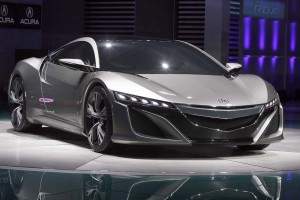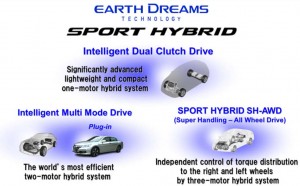So far, most hybrid systems have been designed as one-size-fits-all technology. Sure, a few software tweaks might shift emphasis from mileage to performance, but the approach led to significant compromises when the same hybrid driveline was used across a maker’s entire product line.
No longer, at least not for Honda. As part of its new Earth Dreams powertrain strategy, the maker plans to use three distinctly different hybrid systems. That will allow the maker to choose the one that appropriately reflects the price, capabilities – and performance of the vehicle the system will be used in.
The next-generation Acura NSX, for example, will adopt a distinctive, three-motor Sport Hybrid Super Handling All-Wheel-Drive, or SH-AWD, hybrid that will not only boost the sports car’s fuel efficiency but introduce an electric torque-vectoring system to improve handling.
Honda was the first to introduce a hybrid vehicle into the U.S. market – launching its original Insight in Japan about the same time as the Toyota Prius debuted. But Honda has had far less luck penetrating the emerging market than its bigger rival. It pulled the first-generation Insight due to slow sales and not experiencing much better success with the current version.
But rather than abandon the hybrid market, Honda plans to replace its Integrated Motor Assist system, a mild hybrid that, while less expensive, didn’t offer the functionality of Toyota’s Hybrid Synergy Drive.
Newest of the three systems Honda now plans to offer is the Sport Hybrid Intelligent Dual Clutch Drive. While Honda isn’t providing specifics, it appears to be the most direct replacement for the current IMA technology, at least on small models such as the Insight, CR-Z and even the Civic. The emphasis will be on fuel-efficiency and Honda claims it will achieve about a 30% bump compared to the Integrated Motor Assist now in those vehicles.
As the name suggests, it will use a 7-speed dual-clutch gearbox, rather than the Continuously Variable Transmission-style systems that are found in Toyota, Ford and numerous other hybrid systems. There will be a single motor paired with a 1.5-liter Atkinson-cycle inline-four.
The Sport Hybrid Intelligent Multi-Mode Drive/Plug-In will be a two-motor system also designed to emphasize fuel economy – but on larger vehicles — and will make its public debut in the Accord PHEV during an introduction at this month’s LA Auto Show.
This system will feature an I-4 engine designed specifically for hybrid applications and will opt for the more traditional CVT-style gearbox. It appears the drive system could be used for both plug-ins and conventional hybrids. In EV Drive mode, the emphasis will be on operating on battery power, while Engine Drive would be used when the charge is low – and at higher speeds that would otherwise discharge the battery quickly. In EV Hybrid mode, the gasoline engine will primarily serve as a generator to power the twin motors – much the way the Chevrolet Volt operates when its battery is discharged.
With the SH-AWD system, Honda shifts focus to performance. Essentially a battery version of the mechanical Super-Handling All-Wheel-Drive technology found in the likes of the Acura MDX, there are three motors paired to a direct-injected 3.5-liter V-6. In most versions, a 7-speed dual-clutch gearbox will deliver power from the gas engine and a single motor to the front wheels, with twin electric motors providing a through-the-road all-wheel-drive system with torque vectoring for the rear wheels.
The NSX, Honda officials explained to TheDetroitBureau.com, will reverse that layout with a mid-rear-engine design delivering IC/electric power to the rear axle and the second and third motors mated to the front wheels. The reborn sports car is expected to debut sometime around 2014.
“Using independent motors for the right and left rear wheels, positive torque is applied to the outside wheel and negative torque is applied to the inside wheel, making independent control of torque distribution to the rear wheels possible without relying on engine output,” Honda says, adding that energy to the inside wheel can be “recovered” and re-directed to the outer wheel to add even more acceleration.



“The Sport Hybrid Intelligent Multi-Mode Drive/Plug-In will be a two-motor system also designed to emphasize fuel economy – but on larger vehicles — and will make its public debut in the Accord PHEV during an introduction at this month’s LA Auto Show.”
Paul, do you think that Honda has plans for this system in other “larger vehicles” – like the Odyssey? One of the minivan builders needs to offer a hybrid minivan to the market. Given how so many are used as the family bus, the hybrid capability will be an easy sell.
I would not be surprised to see Honda move up to the Odyssey with this hybrid system…though I have so far heard of no specific plans.
Paul E.
Just a quick follow-up. My very good sources tell me that there is a packaging issue that will not allow the use of a hybrid drivetrain with the current Honda Odyssey platform.
Paul E.